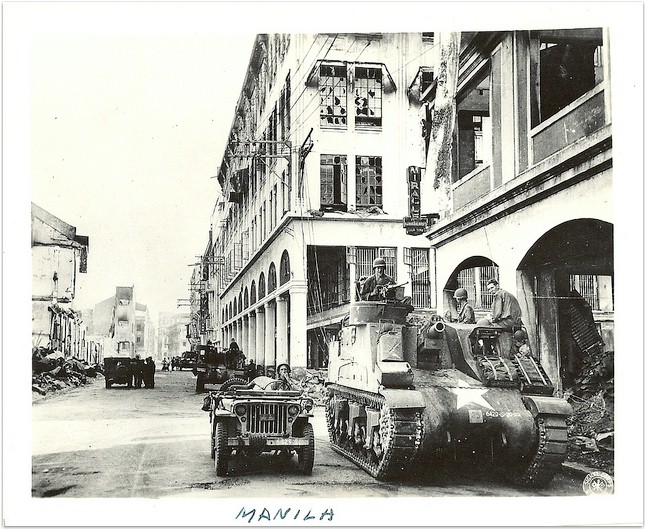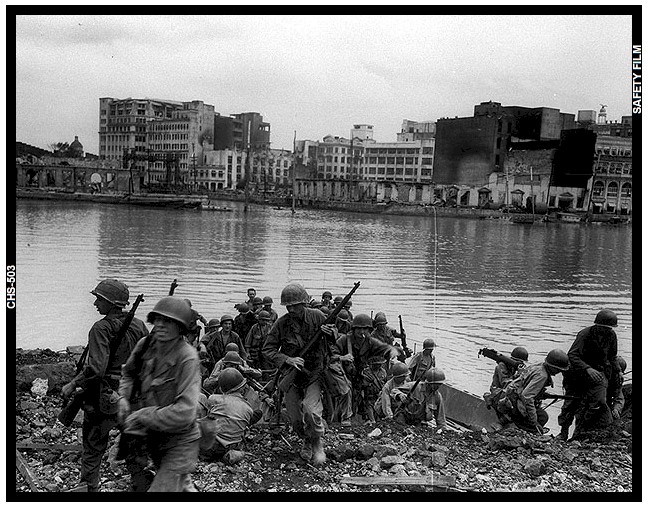|
6. Assault
on Intramuros

The assault upon Intramuros was unique. A thick masonry wall averaging 20
feet in thickness surrounded Intramuros. Extensive gun emplacements and
tunnels in the wall itself had been constructed by the Japanese. Maximum
use was made of the apparently impregnable cover to protect enemy
defensive installations. The assault upon it was characterized by a
prodigious use of direct fire artillery, tanks, tank destroyers, and
overhead artillery fire for one hour prior to the attack. In the final
assault of the WaIled City, the 145th Infantry Regiment used an entire
company of medium tanks, an entire company of tank-destroyers, a special
assault-gun platoon, two flame thrower tanks, and the regimental M-7's
from the Cannon Company plus an additional platoon from the 148th
Infantry. Artillery pieces up to and including 155mm howitzers were used
in direct fire missions also, but their particular vulnerability to small
arms fire precluded their extensive use. Great difficulty was had in
getting direct fire weapons across the Pasig River and into position
because of the intensity of enemy fire. The whole attack on Intramuros was
delayed until the heavy assault guns could be brought over and placed into
battery. The main purpose of the direct fire was to breach the walls, and
two places were selected where the masonry was to be opened. Such was the
organization of fire that each gun had its own part of the area in the
wall to be destroyed. The hour's bombardment, however, did not open the
wall cleanly, but rather crumbled it so that foot troops could climb over
without having to use ladders. When the breaches were made, one at the
North end of the city and the other at the Northeast corner, the assault
units moved in.

The 129th Infantry attacked across the Pasig River from the North in
assault boats (after shooting steps into the river embankment with 76mm
tank destroyers), while the 145th Infantry attacked overland from the
West. So heavy was the preparation, that entrance was gained almost
without opposition. Once our units were inside Intramuros, normal street
fighting again took place, except in Fort Santiago. This was a medieval
fort, containing many dungeons and deep recesses and tunnels, filled with
Japanese. Among the expedients found workable in combating the enemy
therein was the sealing of deep cavities by demolition teams. The
extinction of other pockets to which access was difficult was effected by
pouring gasoline into them and igniting it with WP grenades.

The Parian Gate was one of the 7 gates of Intramuros - so named as it
was the only portal by which the Chinese - parias (Hindu for "outcasts") -
could enter and leave Intramuros. The Parian Gate was, after 1765,
the gate the new governor officially entered the city and received the
keys.
7. Special Techniques
a. Observation Posts in Street Fighting
In some cases it was very helpful to have an observation post in a high
building some distance to the rear of the attacking units, with direct
communication to the attackers. Because of the limited visibility in many
cases this rear CP was able to observe and report to the attacking company
actions and locations of the enemy. In closein fighting, the attacking
companies should have the SCR 300 channel number of the adjacent units, so
that in an emergency direct communication may be established by switching
to the appropriate channel. This means is recommended only for emergencies
or situations where the information might become worthless after a few
minutes ; for example, enemy escaping from a strongpoint.
b. Use of Flame-throwing Tanks
In one instance, Japanese held the second floor of a building and
commanded the stairways by the use of hand grenades thrown from sandbagged
positions out of sight. A flame-throwing tank was brought into the doorway
and maneuvered into position to shoot flame up the stairs into enemy
defenses. The Japanese were driven out and the assault troops siezed the
stairs. On another occasion a flame-throwing tank discharged its flame
through a window into a deeply recessed and sandbagged machine gun
position, destroying the enemy.
c. Effect of Unfused Projectiles on Walls
Considerable advantage was thought to be gained by the use of unfuzed
155mm HE shells for the purpose of opening holes in heavy walls. While the
ballistic properties are not noticeably different without the fuze,
observers agreed that the initial penetration with unfuzed shells created
a more pronounced fissure than was caused by the use of HE with fuze
delay. This fissure responded readily to subsequent use of HE with fuze
delay.
d. Night Operations
Night attacks through the rubble and debris of a defended city are
extremely difficult and hazardous. The many hiding places make it
impossible to keep from bypassing Japanese who have to be hunted out the
next day. Movement is difficult and silence is almost impossible. Any
attacks made at night in the city should be local and against known
positions and terrain. Attacks against buildings should not be launched
after 16001 . The enemy had the distinct advantage of being in the dark
while our troops were definitely silhouetted when approaching the
building. Also the large number of mines used by the Japanese in Manila
made night movements extremely dangerous. Moves of a minor nature are
desirable and advantageous, but large-scale and continuous moves should be
avoided. Usually the danger of disaster involved is too great to
compensate for the advantages gained.
8. Conclusions
a. Street fighting in Manila was normal and advanced no principles or
tactics not already covered in FM 31-50.
b. The stubborn Japanese defense of large fortified buildings standing in
open ground necessitated use of combined tactics of assault on fortified
positions and combat in towns, in order to secure their reduction.
c. The unique situation of assaulting a medieval rampart presented itself.
Large numbers of assault guns and artillery pieces including those of
medium caliber were laboriously and dangerously emplaced within close
range of the rampart, and only after employing direct fire and heavy
bombardment did the guns succeed in driving the defenders from the walls
and opening breeches for assaulting troops.
|

